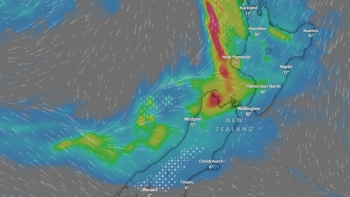The Government has released its three-phased approach on how it will tackle the Omicon variant spreading through the community.
"As case numbers grow, both testing and isolation approaches will change in response," Associate Minister of Health Dr Ayesha Verrall said this afternoon.
"Omicron is here, and we have changed our strategy," she said.
Verrall said it was important New Zealand minimised the impact of Omicron, and the Government wanted to protect essential services.
Verrall said case numbers were likely to grow rapidly.
A 10-case outbreak could reach 1000 cases in six to 12 days, she said.
"I know these sorts of case numbers will sound scary to some people."
But she said Omicron was markedly less severe than earlier strains.
"For most people, Omicron [will] be a mild to moderate illness that you can manage at home."
The associate minister said booster shots would be critical to reducing strain on hospitals. She said clinics and drive-through vaccination centres were among the places where boosters will be available.
About one in five children were already vaccinated or had bookings, Verrall said.
Steps will include:
- Reducing isolation period for cases and close contacts at Phase Two and Three to 10 and seven days;
- Definition of close contact required to isolate changes to household or household like contacts at Phase 3;
- Increased use of rapid antigen tests with a test to return policy put in place for health and critical workforce;
- Greater use of technology, including text notifications for cases and close contacts and automated contact identification.
Verrall and director-general of health Dr Ashley Bloomfield addressed the media about the plan, as outlined below:
Phase 1
"Phase 1 is where we are now and we are doing what we have successfully done with Delta – taking a 'stamp it out' approach, Verrall said.
"Broadly speaking, that includes the same contact tracing, isolation, and request that everyone who is symptomatic be tested at a community testing station or at a primary health provider.
"If you are required to isolate, you will receive advice and – if needed – support to do so; at this phase you will need to isolate for 14 days if you are a case, and 10 days if you are a contact.
"Our objective is to keep cases as low as possible for as long as possible to allow people to be boosted and children to be vaccinated without Omicron being widespread," Verrall said.
Phase 2
Phase 2 is about trying to slow the spread and protect our vulnerable communities, she said.
"In phase 2, we will reduce the isolation period for cases to 10 days and contacts to seven days in line with best practice overseas.
"Household contacts will actively be managed by contact tracing services, with close contacts requiring a PCR test on day five.
"A rapid escalation in case numbers and the resulting pressure on our resources will also require us to shift from identifying all infected individuals to being more targeted to those most at risk and those needed to keep the country going.
"Digital technology is used more in this phase. Cases will be notified via text message and be directed to an online self-investigation tool which will focus on high-risk exposures. Information will be provided via email and phone-based interviews will still take place where it's required. Other forms of support will be available to those who need it.
"We will also change our current testing requirements for critical workers who are close contacts of cases. The prime focus of testing and tracing will be protecting this workforce and those most vulnerable to becoming severely unwell.
Phase 3
Phase 3 is for when cases are in their thousands, Verrall said.
Further changes will be made to the contract tracing system when New Zealand reaches this point.
"Supported self-service, rapid antigen testing for diagnosing Covid and a self-service tool to enable identification of high-risk contacts will be significant to respond to the high volumes of Omicron cases.
Digital technologies will continue to be utilised at this phase, and people will be supported to self-notify close contacts. There will be continued support for those members of our community who are not digitally enabled.
The majority of people will be supported and be able to self-manage and isolate at home; and clinical care will focus on anyone with high needs.
Clinical care and welfare support will be targeted based on need.
"Through the course of phase two and three, we have a test to return regime that will apply to our critical workforces, to keep them going through the outbreak.
Today, 23 new community cases of Covid-19 were announced, 15 of which are Omicron cases.
Six people are in hospital with the virus.
The Ministry of Health today said 56 community cases have been confirmed as an Omicron case through whole-genome sequencing, or are a suspected Omicron case because they have an identified link to a confirmed Omicron case.
That included 44 cases linked directly or indirectly, to a family event and other associated events in Auckland on the weekend of January 15 and 16.
Verrall said it might be difficult for Kiwis to acclimatise to Omicron, because the country had been relatively unscathed in previous Covid-19 outbreaks.
Bloomfield said some people were asking if New Zealand was shifting to living with the virus.
"We have lived with it, on our terms. And we want to continue doing that."
"As case numbers grow, testing and isolation approaches will change in response," Verrall said.
Tools used in elimination strategies, such as intensive contact tracing, could still be used to tackle Omicron.
As indicated at the weekend, the second stage of the Omicron strategy will involve identifying people most at risk of getting severely ill from Omicron, Verrall said.
"Any rapid increase in case numbers will put pressure on our resources."
Contacts will receive text message alerts and may be directed to an online Covid-19 health hub.
Authorities were working to figure out which people did not have internet access, Verrall said.
The Healthline phone service would still be important, she said.
Verrall said protecting food distribution networks and utilities was critical, and the Government was working to identify other priority sectors.
Strict protocols including face mask use, ventilation and physical distancing would be activated around returning to work, Verrall said.
Regular workplace surveillance testing will still be encouraged, she said.
Testing procedures may change
The prevalence and intensity of Covid-19 testing will evolve if Omicron cases rose dramatically.
"Rapid antigen tests will become the big go-to testing tool."
Verrall said energy and food supply companies were already receiving rapid test kits.
"Testing will remain free and available when you need it," Verrall said.
Additional changes will be introduced in the third stage, if simultaneous case numbers reach the tens of thousands.
"Locations of interest and push notifications will be paused."
Public health units will focus on managing the pandemic in at-risk places such as prisons and aged care facilities, she said.
Iwi, Pacific providers and other NGOs will be able to provide support in addition to measures public health units will take.
"Get boosted, wear a mask in indoor settings," Verrall added.
She repeated the "going hard and early" mantra the Government used in earlier stages of the pandemic.
"But the health system cannot do it alone."
Asked about people living in large households who might have to isolate, Verrall did not directly answer but said close contact definitions were likely to change as the Omicron surge progressed.
Verrall said actions taken now around boosters and mask use would influence the pace at which Omicron accelerated.
"It is not a foregone conclusion how quickly the Omicron outbreak will spread."
Verrall disputed claims the Government was seizing rapid antigen test kits which had been destined for the private sector.
"We're not commandeering all the stocks," Bloomfield added.
He said some stocks on the way would be consolidated into a single stockpile.
Bloomfield said it was important to prevent a chaotic distribution of the rapid test kits, and to control the flow of these tests.
He said the health ministry was buying rapid test kits on the Government's behalf.
"We have orders in for around 40 million tests between now and the end of February."
But in only about a third of those orders were delivery details confirmed, Bloomfield said.
"Numbers are likely to be less than 1000 day when [we're] moving between phase one and phase two," Verrall said, returning to the topic of the three-stage approach.
She reiterated that the final stage in the anti-Omicron campaign would likely commence when case numbers reached the tens of thousands.
Basis of the three-stage plan
Verrall said the three-stage plan was based on assessing multiple scenarios about how the Omicron outbreak could eventuate.
In other words, the plan was not based on modelling alone.
She said Omicron's intensely transmissible nature meant even if a small proportion of its victims fell ill, the hospital system could still face pressure due to huge case numbers.
Bloomfield was asked about N95 masks, and repeated his entreaty made yesterday for people to fit the masks properly.
The director-general, asked about whole genome sequencing, said two Omicron subtypes had been identified. One strain seemed to be achieving dominance now, he added.
On contact tracing, Verrall said the system was imperfect, but it aimed to identify the majority of contacts.
Bloomfield said the Government still aimed to crush current Omicron clusters, which was why the 10 and 14-day isolation periods were activated.
"The isolation periods are designed to minimise the risk of further spread," he added.
Verrall said perhaps only two per cent of cases were escaping scrutiny when these long isolation periods were mandated.
But she said if case numbers ballooned, these isolation periods may not be sustainable or effective.
The associate minister again insisted no private sector rapid antigen kits (RATS) had been requisitioned.
"There was no guarantee that anyone's forward orders were going to be filled."
She said global supply chain bottlenecks were hampering the distribution of RATS.
Bloomfield said he had advised RATS deliveries be prioritised for the all-of-Government testing kit motherlode.
"The challenge here is not the size of the orders," Bloomfield said.
Instead, he said the exact amounts which were deliverable were a challenge to figure out, and the situation was volatile.
Bloomfield repeatedly said the health ministry would support businesses to access RATS.
The rapid tests had shelf lives ranging from about two to six months, Bloomfield added.
Verrall said RATS were already available at some community health providers, including in isolated areas.
The associate health minister said about 97 per cent of Kiwis lived "within 20 minutes" of a pharmacy.
Māori consultation
Asked about consultation with Māori, Bloomfield said he would meet multiple Māori health organisation representatives by Zoom tomorrow.
Bloomfield said the knowledge many Māori received vaccine doses after the general population was one reason the second jab to booster shot interval had been reduced from six months to four.
Verrall said the broader three-stage strategy was mostly about how public health systems would operate in a potentially volatile environment where Omicron was running rampant.
Bloomfield was asked about possible personal protective equipment (PPE) shortages at pharmacies.
He said New Zealand seemed to have a stockpile of about 145 million medical masks - excluding millions of N95 masks - and other PPE, so he wasn't sure what the problem was.
Verrall said the three stages of the Omicron response would all happen within the existing red traffic light setting.
She also addressed debates about face masks use, and said scientific data would be integrated with practical concerns about how to ensure mask guidance was effective and sensible.
"We're pragmatic about masks."
Mask changes
This afternoon's conference followed an announcement yesterday on new face mask guidance.
Ardern yesterday said makeshift face coverings would be discouraged, and masks would be increasingly required at restaurants and on public school bus trips.
Some restaurant owners have derided the new rules. Others have voiced concern the changes will put staff under more pressure from cantankerous or confused customers.
"Trying to keep up with all the rules is tricky. Then I have to educate my customers every day about it," Devonport cafe owner Peter Reeves told the Herald.
But epidemiologist Prof Michael Baker said the new rules should go further, and the Government ought to clarify mask standards and improve access to quality masks.
Some businesses have told the Herald the Government was seizing private supplies of rapid antigen tests to bolster its own stocks.
In a Yale University article published yesterday, public health professor Dr Albert Ko said Omicron appeared to be twice as transmissible as Delta.
Hospitalisation and death rates from Omicron appeared to be significantly lower than from Delta, but high case numbers could still place pressure on hospitals.
And as existing vaccines are thought to be less effective at thwarting Omicron than at stopping Delta, the Government has encouraged people to get booster shots.
- by John Weekes, NZ Herald
Take your Radio, Podcasts and Music with you









